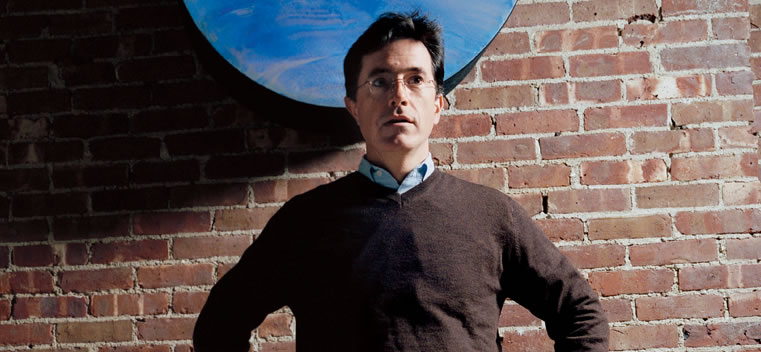
The Real Stephen Colbert
Related Articles
Online Exclusive:
Catching Up with Colbert's Friends
Online Exclusive:
Rooming with Stephen Colbert
Online Exclusive:
'Colbert Bump' for Northwestern
Online Exclusive:
Who's Not Honoring Stephen Colbert Now?
Cate Plys (J84) of Chicago is a playwright and former political columnist for the Chicago Reader and the Chicago Tribune. Her recent work has appeared in Slate and Time Out Chicago.
Comments. Questions. E-mail the editors at letters@northwestern.edu.
Find Us on Social Media
Comedy Central star goes beyond truthiness about his Northwestern days and why he gave up drama for improv.
Stephen Colbert donned a skintight speedskating suit last year at age 45 for the cover of Sports Illustrated, modeling an outfit only slightly more forgiving than a thong.
In 2006 he mercilessly dissected President George W. Bush’s Iraq war policies onstage at the White House Correspondents’ Association dinner as Bush listened from one seat away.
“He believes the same thing Wednesday that he believed on Monday, no matter what happened Tuesday. Events can change; this man’s beliefs never will,” Colbert intoned with a perfectly straight face.
How do you embarrass this guy?
National Enquirer executive editor Barry Levine managed it during an August appearance on The Colbert Report (Comedy Central, weeknights at 10:30 p.m. CST).
“What do I have to do to be salacious enough to make it onto [your] cover?” Colbert demanded.
“Unlike Rush [Limbaugh], you don’t have a prescription pill problem,” Levine answered. “Unlike Matt Lauer, you’re not running all over the place with people other than your wife. The bottom line is, you live a good life.”
Colbert put his hand over his mouth, chagrined. The country’s most arrogant, obnoxious faux conservative TV pundit isn’t just faking his extreme politics. He’s faking the arrogant and obnoxious part, too.
DON’T PRONOUNCE THE “T”
For those who haven’t caught his act yet, let’s recap: Stephen Colbert (C86) plays a character named Stephen Colbert on the award-winning Colbert Report, which draws an average nightly audience of 1.2 million viewers.
Stephen Colbert the character began as a correspondent on Comedy Central’s The Daily Show in 1997 and evolved into a satiric embodiment of right-wing TV hosts and self-important journalists — principally based on Fox News’ Bill O’Reilly, with a dash of Stone Phillips and Geraldo Rivera. The Report launched in 2005, with Colbert as executive producer.
As for the oft-discussed pronunciation of his last name, Colbert decided to drop the “t” on his flight to Chicago to attend Northwestern. “Colbert” is pronounced “Cole-bear,” and, naturally then, “Report” is “Repor.”
The real Colbert calls his ultra-conservative blowhard alter ego “a high-status idiot.” The character’s take on recent Census Bureau figures showing that 43 million Americans lived below the poverty line in 2009 is typically horrific: “These statistics are awful for the obvious reason that they threaten the Bush tax cut for the wealthy.”
Meanwhile, former Northwestern colleagues rave about the real Colbert: Remarkably lovely. Completely deserving. Nice, nice, nice.
And the amazing thing is, they mean it. The real Colbert is a devoted suburban New Jersey husband and father of three and former Sunday school teacherwho promotes charities such as DonorsChoose.org and the Yellow Ribbon Fund.
At his Manhattan office, told about the accolades from his Northwestern classmates and professors, real Colbert responds first with classic TV Colbert bravado. “Fooled ’em. Fooled ’em again!” he barks.
Then he gives up and lays his head on his desk, face down, in pure mortification. (Finding: He really does have a great, thick head of hair.)
Colbert is taking a midday break in his punishing production schedule, creating and performing new shows four nights a week for about nine months each year. The Colbert Report operates from a brick townhouse attached to a blocky, windowless studio building. The townhouse offices are homey, with exposed red brick walls and staffers’ dogs padding around the place. Colbert’s second-floor windows overlook West 54th Street, and the room feels like a comfy den. On TV Colbert dresses in staunchly conservative dark suits and appropriately striped ties. Here it’s khakis and polo shirts.
Colbert gets away with his almost incomprehensibly offensive statements because he does it in character. But it’s also because this Stephen Colbert — the one who pushes his face into his desk when he hears too many compliments — makes TV’s Stephen Colbert capable of insulting everyone in his audience to thunderous applause.
“We try very hard to let the audience know that we’re having fun, not just making fun,” Colbert explains. “That’s why, as professional as I like to be, if occasionally I get caught enjoying the show — I try not to, I try to stay very straight in character, even though he’s a ridiculous character — if occasionally it slips that I’m enjoying myself maybe even more than the audience, that’s OK. I think it’s important that they see me every so often enjoying it, so they know that I’m not as big a jerk as that guy.”
By “that guy,” of course, he means Stephen Colbert.
Before each taping, Colbert enters his glowing, narcissistic set — his name emblazoned everywhere, his desk itself forming a giant “C” around him — and engages the audience. “Any questions to humanize me in your eyes before I start saying these terrible things?” he calls cheerfully before a September show.
“It’s all in such positive spirit with such radiantly positive energy that it’s both infectious to watch and be a part of, and you can’t be offended by it,” says former classmate Aaron Posner (C86), who co-founded Philadelphia’s Arden Theatre Co. and has won prestigious Barrymore and Helen Hayes awards as a director and playwright. “He’s got this Tom Sawyer positive prankster in there. It’s all a joke, but it’s never mean-spirited.”
Colbert doesn’t just work with a script. He has to improvise his character’s response as the show develops, particularly during guest interviews, figuring out how to make his point by saying the exact opposite. In contrast, Colbert’s equally acclaimed colleague, Daily Show host Jon Stewart, essentially plays himself on TV. So Colbert plays Ginger Rogers to Stewart’s Fred Astaire — doing everything backward and in high heels.
“I think it’s impossible what he’s doing,” says Posner.
“You wonder, ‘How does Stephen do it?’ ” says former roommate Eric Goodman (C87), now a Disney “Imagineer” and show producer of Epcot Center’s The Sum of All Thrills simulated ride. “He has to twist it in his head so he says something completely absurd, which he would never say in real life, but seems completely plausible.
“Here at Disney, I’m lucky,” observes Goodman. “I build something and it’s there for 50 years. He has to reinvent himself every day.”
THE NORTHWESTERN YEARS
The real Colbert explored his ancestry this year for Harvard professor Henry Louis Gates’ PBS series Faces of America and found out his DNA is entirely European — Irish-German. “I am the inescapable black hole of white people,” he quipped.
Where does the TV Colbert come from? Northwestern friends see a direct line between Colbert’s work at Northwestern and his late-night character.
As a senior Posner directed Colbert in a Northwestern production of Mark Leib’s Terry Won’t Talk. Colbert played a high school principal, says Posner, “very much a cigar-chomping, blue-blazered, high-status idiot. So it was territory he was already exploring as far back as then. Like now, he could play fairly reprehensible people in a way that you still really liked them.”
(In fact, Colbert performed soon after graduation in a tiny Chicago production of a play focusing on the feminist struggles of Susan B. Anthony and Joan of Arc. A reviewer noted Colbert, “who plays the marshal, the judge and other openly hostile characters, makes them all seem intelligent and dashing, not despicable.”)
The cigar-chomping, high-status idiot also traces back to a character Colbert and friends started playing with after a group of agents visited campus looking for acting prospects, say former roommates.
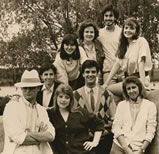
The Journeymen Theater Ensemble on campus in 1986
Mary Siewert Scruggs (C86), now head of writing and education programs at the Second City Training Center, used the agent character to write the part of the miller for Colbert in Rumpelstiltskin v. the Queen, the first of several plays in the Fairy Trials, an educational program for the Circuit Court of Cook County. Scruggs, Colbert and a group of fellow then-recent Northwestern grads — all from a class taught by associate professor Ann Woodworth (C75, GC79) — formed the Journeymen Theater Ensemble and made Rumpelstiltskin a main project, taking the play to schools around Cook County.
“Whenever that character was enacted, there was always an invisible cigar — you had to chomp down on the invisible cigar,” says former Colbert roommate and Journeymen member Kellie Overbey (C86), now a Broadway actor whose credits include Sam Shepard’s Buried Child.
Sure enough, Colbert brandishes the invisible cigar as he remembers the agent. “Uh, listen kid, llllook,” he growls. “You are what we call a natural. I’m on the phone. I’ve got six numbers dialed here. I push the seventh number, your career changes. Sign here, just sign here.”
Colbert would go on to perfect his high-status idiot at Second City and later with friends and fellow Second City performers Amy Sedaris and Paul Dinello through two early series on Comedy Central — the sketch comedy program Exit 57 and the cult classic Strangers with Candy.
In Strangers Colbert played teacher Chuck Noblet, a married father carrying on an obvious gay affair with the school’s art teacher. Noblet constantly misinforms his classes in the most authoritative voice possible: “The tragic irony of the Trojan War is that, though it was fought over Helen, who was young and beautiful, by the time they rescued her 10 years later, she was old and ugly.”
Noblet “was sort of high-status but secretly low-status,” Colbert muses. “In a way he had a self-awareness that this guy I’m doing right now [the character Stephen Colbert] doesn’t have. Because he actually had a lot of secrets and was very injured, whereas my [Stephen Colbert] character is really not that injured.”
Colbert transferred to Northwestern as a junior from Virginia’s all-male Hampden-Sydney College, completing Northwestern’s three-year acting program in two years.
He also worked two student jobs — the cafeteria line at 1835 Hinman and computer data correction at the library, which he calls “just put-a-gun-in-your-mouth work.”
Senior year Colbert took both the Shakespeare and George Bernard Shaw acting sequences simultaneously, but finally dropped Shaw. “I was just pushing myself too hard,” he says. “I weighed about as much as a kitten.”
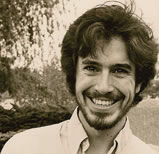
Colbert on campus in 1986
During this period of his life he has described himself as a self-important “poet/jerk,” planning on a serious acting career and walking around in black turtlenecks. Yet he’d already discovered Chicago improv. Colbert says friend Chris Pfaff (C87) first took him to the now-defunct Crosscurrents club in Chicago to see teams at the fledgling ImprovOlympic, now iO, perform “the Harold,” an improv game invented by iO founders Del Close and Charna Halpern.
“I said, ‘I have to do this. I have to improvise,’” Colbert recalls. “I just loved going onstage with nothing planned and, through agreement, trying to create a one-act play, which is what they did.” Colbert began performing weekly with a Northwestern improv team called No Fun Mud Piranhas, which included David Schwimmer (C88), later of Friends fame. “I still have my No Fun Mud Piranhas T-shirt,” Colbert notes proudly.
Back on campus, Colbert played Golaud, one of the three leads in Pélléas and Mélisande by 19th-century symbolist playwright Maurice Maeterlinck. Colbert’s character (center in photo below) eventually finds his wife and brother together and kills Pélléas and wounds Mélisande, who later dies after childbirth.“The play was terrible, awful — shouldn’t have been seen onstage,” says Ayun Halliday (C87), a New York City writer who was Colbert’s girlfriend at the time and part of the chorus.
Jennifer Cohen Estlin (C87), now executive producer of Chicago’s Annoyance Theatre, was chorus master. “The set was this gigantic metal structure, and [the chorus members] were supposed to be a living background,” Estlin recalls. “We were wearing unitards that were painted and had this rubbery stuff that accentuated our bodies, and we would hang from this structure and move around while the show went on, and it was incredibly difficult and very uncomfortable.”
“The whole concept of this giant wall of human bodies was cool as hell to watch,” says the play’s stage manager Anne Libera (C86), another former Colbert roommate who is now director of Comedy Studies, a joint Second City-Columbia College Chicago program. “But for that poor group of actors — they were basically on a metal lattice for an hour-and-a-half going ‘Ooohhhhh, ooooohhhh.’”
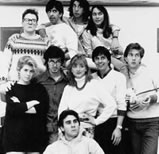
The No Fun Mud Piranhas improv team
Estlin remembers one long, agonizing rehearsal in particular. “Stephen and Melissa McFarlane (C86) [who played Mélisande] were having a really hard time, and we were hanging from this thing and just dying, and she had this line, ‘I am not happy here.’ And Stephen just looked at her and started laughing and said, ‘Neither am I.’ That kind of gave voice to all of us.”
When Golaud discovers his wife’s infidelity, says Halliday, Colbert roared onstage with a battle-ax over his head. “I was draped over the doorway, totally bored, with my foot hanging down, and he almost lopped off my bare foot with a prop,” she says with a laugh.
That role, says Libera, “was a huge stretch” for any 21-year-old. “It’s a part for Brian Dennehy — now,” she insists. “So God love him, he did his level best … but he was in a pour-foam chest!”
“Not that I wasn’t ripped at the time,” says Colbert before admitting, “I had a chest like a baby duck.”
Most friends weren’t shocked when Colbert ended up, only two years out of college, with the Second City touring company. “There was always this dichotomy. He loved diving in deep, but there was that part [of him] that stands aside and sees the ridiculousness of it,” says Libera.
Everyone in Woodworth’s acting class “thought we were going to be doing Chekhov,” says former Colbert roommate Christopher Baker (C85), senior dramaturg at Hartford Stage in Connecticut. Baker can see how the foundation of those classes “serves [Colbert] in a different way in his comedy. Because clearly in what he’s doing there’s something very serious underneath.”
“Stephen, if you just look at him, that was his destiny, to be the romantic, dashing lead in a melodrama. But it wasn’t for him — it didn’t feed him,” says Alan Goldwasser (C87), a friend who did improv with Colbert. “Where he really shone was thinking on his feet, and I think relying on his looks or stature or presence alone and speaking somebody else’s words wasn’t as exciting for him as creating on the fly on his own.”
“On a recreational level he liked to improvise a play and adopt characters,” says former Colbert classmate Scruggs. “We didn’t have a TV, so you’d just hang out in someone’s living room, and he’d adopt a character, someone else would adopt a character, and we’d have conversations that way for an hour. He was wickedly funny always and could crack up a room like nobody else.”
Woodworth, Colbert’s acting professor who is now teaching at Northwestern’s Qatar campus, remembers him as a “constant clown” who had trouble accessing “some of the emotions that were necessary to tap into the more tragic plays and characters.”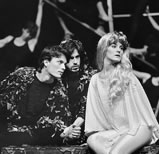
Stephen Colbert, center, in a campus production of Pélléas and Mélisande.
Then, she says, she was having lunch with Colbert one day at Norris. “I don’t know how it came out,” Woodworth recalls, “but he said, ‘Well, it might have something to do with the fact that my father and two brothers were killed in a plane crash when I was 10, and I was left home with a grieving mother. And my main mission became to make her laugh.’
“I can remember exactly where I was sitting in the lunch room when he said that because I thought I was going to fall over. It made all kinds of sense to me why it was difficult for him to get to the grief of Hamlet. And then it also made sense to me why his sense of comedy and his ability to entertain people and make people laugh was so strong, because he had been practicing it for 10 years.”
Colbert grew up the youngest of 11 just outside Charleston, S.C. His other siblings had left home by 1974, when the plane crash killed his father and two next oldest brothers. Speaking of that time period, he has described himself as being somewhat alienated from schoolyard issues, which no longer seemed important. He also began a lifelong fascination with science fiction and fantasy, diving into Dungeons & Dragons and becoming a Lord of the Rings aficionado.
After Northwestern, Colbert’s roommate Libera started work at Second City’s box office and soon brought in Colbert, who “was making futon frames out of 2-by-4s” in the basement of the house they shared with a revolving cast of roommates at Foster and Ridge.
“The futons needed a lifetime guarantee because they kept breaking,” Libera recalls. “I was like ‘Dude, you gotta get a job. Here, you can work here.’ So he worked at the [Second City] box office and sold T-shirts in the souvenir shop. Until fairly recently he held the record for most T-shirt sales in one night.”
Even after joining the touring company, though, Colbert quit four times to go back to straight theater. Finally there came a moment onstage at Second City that clinched it.
“I saw someone fail onstage — terribly, massively fail onstage,” Colbert recalls. “And we backstage laughed so hard at this woman’s failure, and our laughter was so joyful and not derisive. I remember turning to a friend of mine, Dave Razowsky, and we threw our arms out wide and hugged each other in laughter and literally fell to the ground in each other’s arms over the joy of that failure.
“And I thought, ‘This is healthier than straight theater.’ Because in straight theater when someone fails, you come backstage, and people are very quietly sort of touching up their makeup, going, ‘How’s it going out there? It seems pretty quiet.’ … That is the moment when I said, ‘I will do this and not drama, I will do comedy and not drama,’ and never turned back.”
TRUTH AND CONSEQUENCES
The character of Stephen Colbert truly pierced popular consciousness with two breakthrough events. First, Colbert invented the term “truthiness” for the first episode of the Report in 2005, inspired by the war in Iraq and President George W. Bush’s nomination of Harriet Miers for the Supreme Court:
“We are divided between those who think with their head and those who know with their heart,” he said. “Consider Harriet Miers. If you think about Harriet Miers, of course her nomination’s absurd. But the president didn’t say he thought about his selection. … He didn’t have to. He feels the truth about Harriet Miers. And what about Iraq? If you think about it, maybe there are a few missing pieces to the rationale for war, but doesn’t taking Saddam out feel like the right thing?”
Colbert ended with a pledge to his viewers: “The truthiness is, anyone can read the news to you. I promise to feel the news at you.”
Later that year the American Dialect Society voted “truthiness” the 2005 Word of the Year, defining it as “the quality of stating concepts or facts one wishes or believes to be true, rather than concepts or facts known to be true.” Merriam-Webster followed with the same honor in 2006. Soon New York Times columnist Frank Rich was using the word often enough to pay royalties.
Next came Colbert’s famous appearance at the 2006 White House Correspondents’ Association dinner. He started out gently: “Whoever parked 14 black bulletproof SUVs out front, could you please move them? They are blocking in 14 other black bulletproof SUVs, and they need to get out.”
But the main body of Colbert’s speech was filled with thoughts like, “I believe the government that governs best is the government that governs least. And by these standards, we have set up a fabulous government in Iraq.”
The next day, mainstream media either ignored Colbert altogether, like the New York Times, or reported that his speech “fell flat,” as in the Washington Post. Many speculated the press wasn’t amused by the jabs Colbert aimed at them. “Over the last five years, you people were so good, over tax cuts, [weapons of mass destruction] intelligence, the effect of global warming,” he told Washington’s elite press corps. “We Americans didn’t want to know, and you had the courtesy not to try to find out.”
Meanwhile on the Internet, video of the speech reached 2.7 million hits on YouTube in the first two days, and the audio version reached No. 1 on the iTunes Top 10, besting Pearl Jam and the Red Hot Chili Peppers. Frank Rich would call Colbert’s appearance “the defining moment of the 2006 campaign” and “a cultural primary.”
In the aftermath, some accounts portrayed Colbert as uncomfortable with the brouhaha over the dinner. But Colbert insists now the dinner isn’t a sore point. “I’m perfectly comfortable talking about it. I just don’t talk about it. … I may or may not answer your question, but you can ask me anything you want,” he says. “I had a really good time,” he adds with a definite glint in his eye.
Perhaps Colbert didn’t share the same relationship with his audience at the correspondents’ dinner as he does on the Report? Colbert considers his audience part of the show. He sees the show as a scene with two characters — him and the audience. As he learned at Northwestern, “I either want to convince them of something, or I want their trust or their love or their pity or their anger.”
Before every show, as Colbert’s stage manager counts him in, “I turn to the audience and say, ‘Have a good show,’ because they’re the other character. If they’re not there, then I’ve got no friction. I’ve got no one to talk to.”
As for the correspondents’ dinner, he says flatly, “I had a relationship with my audience. But my audience was not the people in that room.”
“What you don’t know,” Colbert goes on, “is that there were 3,000 people in there, and even the things that didn’t go well,” his voice drops to a whisper for emphasis, “a thousand people laughed. … What you don’t know is that the people on the dais in the front row were going like this,” he continues, holding his hands in front of his face and peeking through his fingers. “But it went pretty well,” he laughs.
Colbert’s classmates agree. “That was pretty f---ing great,” says Overbey. “That was even more exciting than the fact that he has a Ben & Jerry’s flavor named after him,” says Halliday.
What’s next? For now Colbert has signed to stay with the Report through the 2012 presidential election, which means he’ll be tired for a couple of more years.
“Sometimes I get concerned about him, because I see the pace at which he’s working,” says Woodworth, Colbert’s acting professor. When Colbert visited her while serving as grand marshal for the 2006 Northwestern Homecoming parade, she says, “he ended up sort of collapsing on the floor in my office and saying, ‘Truthfully Ann, I’m just so tired. I’m so, so tired.’”
Colbert acknowledges it’s a grueling schedule. But, he says, “Early in this process I started calling this place ‘the joy machine.’ Because if it’s not a joy machine, it’s just a machine, is what we like to say, and then you get caught in the gears. Because 161 shows a year is just — can’t be done. You can only do this week’s show, and not even this week’s. You can do tonight, you can do part of tomorrow. But tomorrow’s gonna change before you know it.”
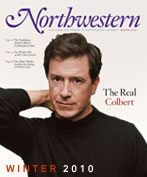


 Facebook
Facebook Twitter
Twitter Email
Email


